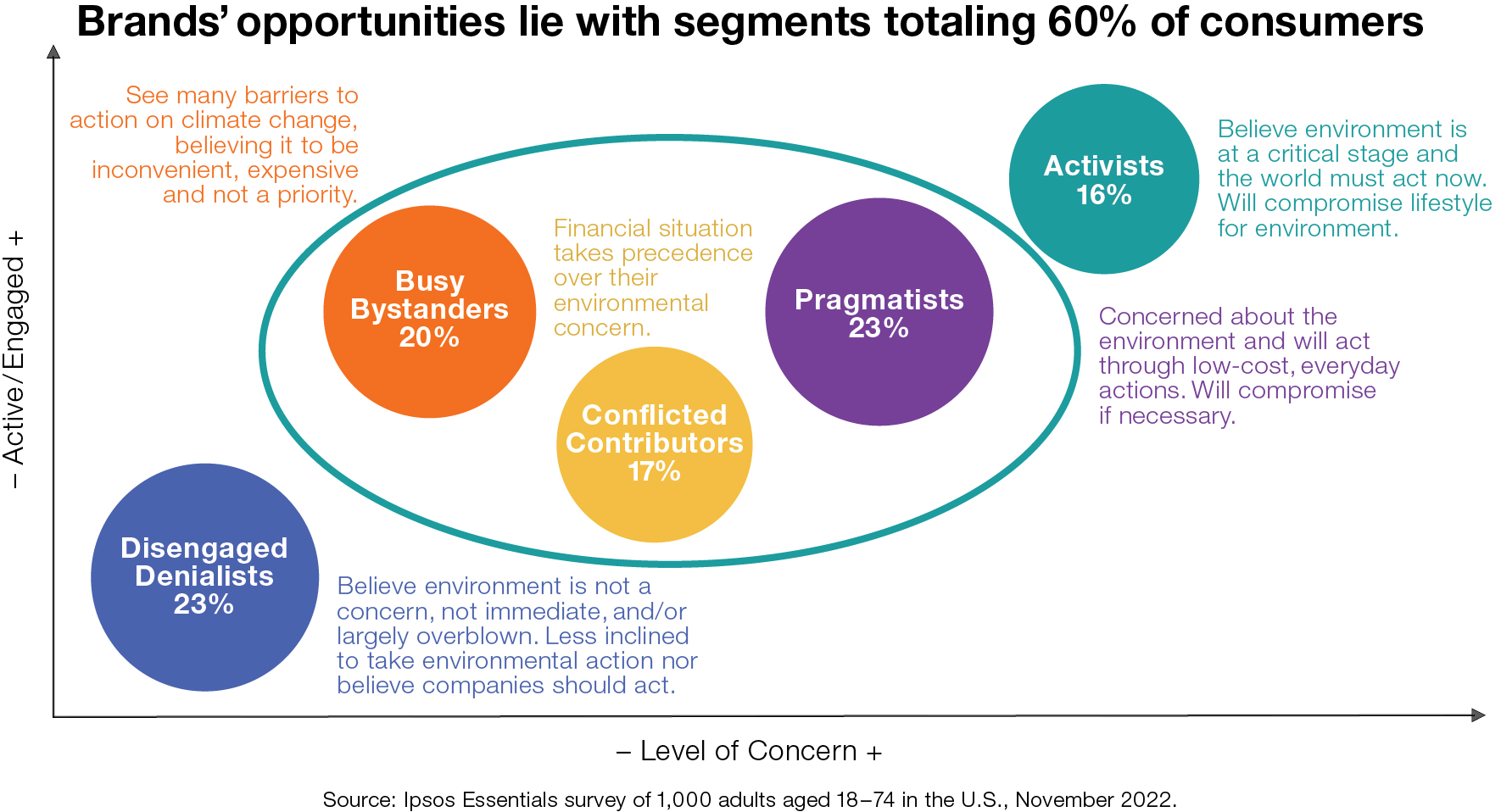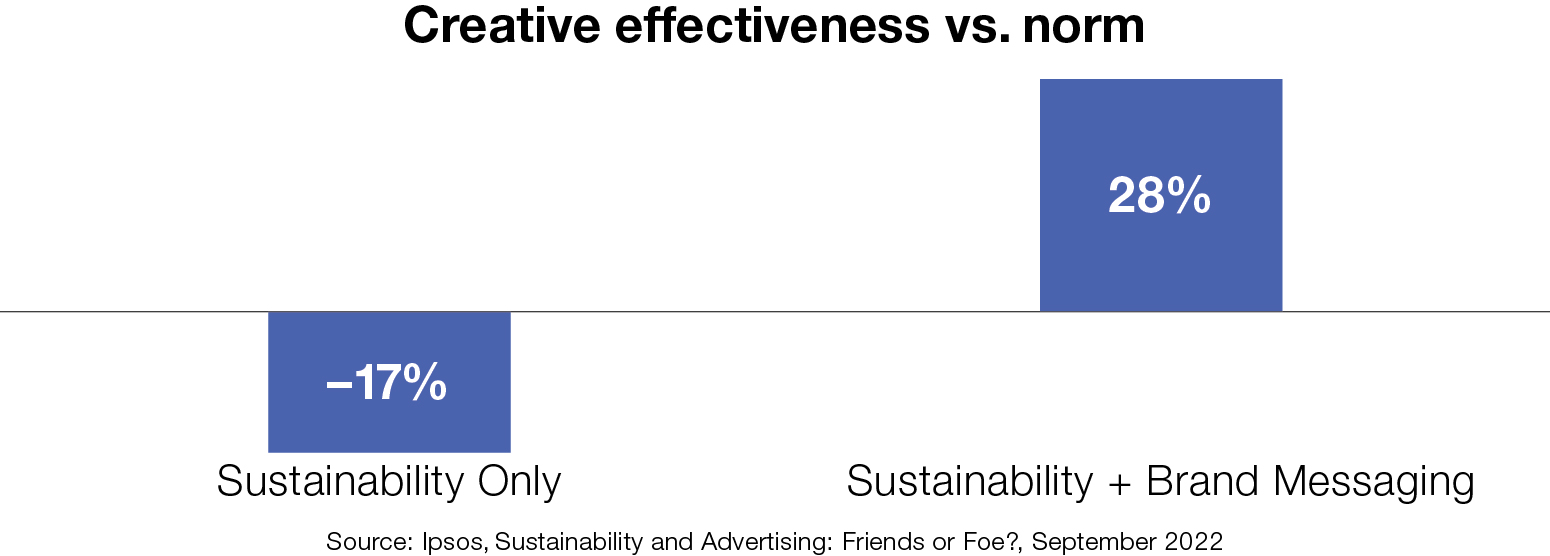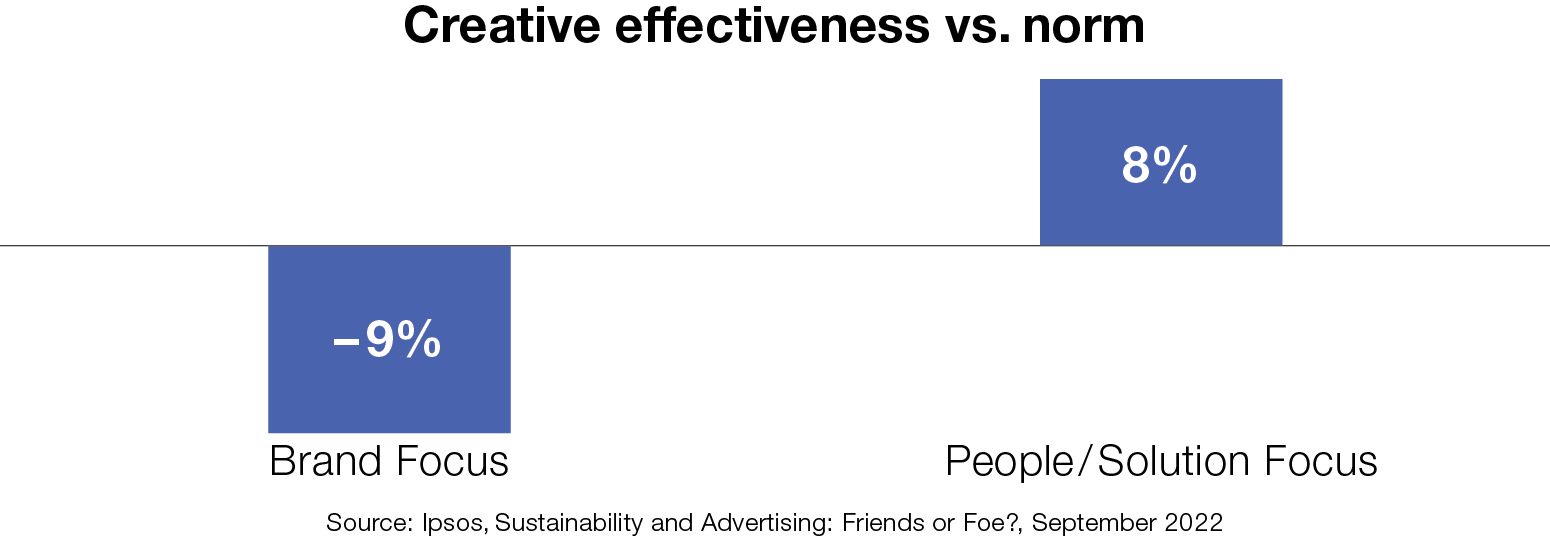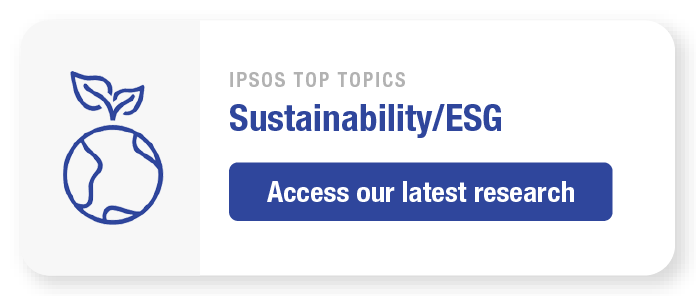Sustainability Advertising: How empathy and credibility can help you get it right
Sustainability has become an important topic for consumers. Awareness and the level of concern around climate change and the environment has been ticking up, and consumers are becoming more engaged and looking for solutions. Brands’ opportunities lie with segments totaling 60% of consumers. For these segments, the barriers to more sustainable choices are ease, cost and convenience.
For many consumers, it is not enough for ads to proclaim a commitment to sustainability goals or principles. Ipsos research shows that success comes from integrating sustainability with brand benefit messaging. Read on as we illustrate what works – and why – using seven in-market ads.
KEY TAKEAWAYS:
- Ads that blend brand and sustainability messages perform strongly, with an average increase of 54% on the overall creative effectiveness performance index.
- Empathy and believability are the recipe for successful sustainability creatives.
Sustainability has become an important topic for consumers. Awareness and the level of concern around climate change and the environment has been ticking up, and consumers are becoming more engaged and looking for solutions. Brands’ opportunities lie with segments totaling 60% of consumers. For these segments, the barriers to more sustainable choices are ease, cost and convenience.

For many consumers, it is not enough for ads to proclaim a commitment to sustainability goals or principles. Feel-good sustainability messages have lower effectiveness, with 5% lower brand attention, and 4% lower in terms of being entertaining. This type of advertising gets lost in a sea of sameness, where brands make similar promises and use similar styles, making it hard to engage and brand.

We find that success comes from integrating sustainability with brand benefit messaging. Ads that blend brand and sustainability messages perform strongly, with a difference of 54% on the overall Creative Effect Index.
We are going under the hood with seven ads to understand how brands can craft successful sustainability messaging with a blend of empathy and believability. These video ads were evaluated with our Creative|Spark assessment tool, which uses a combination of thoughts, feelings, and emotions to measure effects and identify areas that may need to be optimized. Most of these examples had exceptional effectiveness and predicted behavior change, driven by the strong branding and integrated sustainability benefits.
1. Empathy: Recognize the problem but on a human, everyday level
Ads that focus on people and contextualize the problem of sustainability in an everyday way are more effective than ads that reference the scary or overwhelming elements of climate change. When trying to drive home a sustainable message, it’s important to show not only say. This can be done with imagery or statistics, but the ad needs to be clear what the issue is and how the brand can contribute to sustainability.
In terms of execution, this is reflected with the success of the use of the problem-solution setup. Ads that start with the problem outperform in terms of effectiveness, with 11% higher Creative Effect Index.
Grove Collaborative, “Wish-Cycling”
Source: Ad tested with Ipsos Creative Spark, N=150, U.S., Men & Women
This case study from Grove Collaborative, empathizes with the futility of recycling as the problem and provides a solution for the urgent need to switch to sustainable packaging. Grove is above average for being informative (65% agree) and “told me something new” (67% agree). The ad’s free starter kit offer and the call-to-action to go to Grove.com at the end led to the strongest behavior change and creative effectiveness index of the seven sustainability ads tested.
2. Empathy: Focus on a small achievable change
To make an effective ad, identify what success looks like for your brand in the sustainability space. This is especially necessary for brands which historically have not been known for sustainable actions. From there, it is very important that the ad makes it clear how the consumer can be the hero. Educate consumers on how their small changes can make a big impact in a light-hearted, non-preachy way. Ads that show attainable solutions that build easy sustainable behavior have creative effectiveness of +19% on average, driven by choice intent.

One source of success is to lean into the most likely consumer sustainability behaviors. Hellmann’s suggests popular everyday recipes to use leftovers. Hefty says to make a difference in recycling plastic waste, “all you have to do is choose Hefty.” Seventh Generation products are just as effective in smaller plastic packaging.
In the Finish Quantum ad, consumers are invited to “skip the rinse.” It is a small change in behavior that benefits users. By skipping pre-rinsing, they are cutting down on time spent doing dishes as well as helping the world by saving water. As a result, 46% think the brand offers a practical solution to the problem of water waste.
Finish Quantum, Skip The Rinse: Active Lift Technology
Source: Ad tested with Ipsos Creative Spark, N=150, U.S., Men & Women
3. Empathy: Humor and entertainment are powerful tools to drive consumer openness
Humor and entertainment are key tools to help ads be more engaging and stand out from clutter and we find that it works just as well or even better for sustainability ads. Amongst the ads, three were humorous and scored 38 points higher in breakthrough index compared to three ads without humor. Our Ipsos ad database shows that humor in ads results in +13 points on Brand Attention on average. Brands can use humor and entertainment to drive consumer openness to the solutions suggested.
Hellmann’s, Mayo Tackles Food Waste
Source: Ad tested with Ipsos Creative Spark, N=150, U.S., Men & Women
This 2022 Super Bowl ad from Hellmann’s is a good example of using comedy to make a point about sustainability. In the ad, Jerod Mayo, a famous football player, “tackles” food waste with Hellmann’s mayo by providing examples of how to use the product to revitalize leftovers. 74% found the ad to be entertaining and 62% say that Hellmann’s has a good sense of humor.
The ad also uses celebrities effectively to engage audiences. Jerod Mayo and Pete Davidson are portrayed in ways that align with their famous personality and 76% think that Hellmann’s used celebrities in an effective way. Through our ad database learnings, we know that celebrities can buy Attention but their use may lead to lower Brand Linkage and Behavior Change. When celebrities are true to themselves or are shown in a setting in which they have some authority, performance is improved.
4. Believability: Information and news play an important role
Believability is a key challenge for creative focused on a sustainability message. Brands must establish where they can really make a difference and truly commit. Make sure that claims in ads are credible and that they are supported with action. Sustainability is not a skin-deep, check box exercise. There is the risk of “greenwashing.”
According to our Ipsos Earth Day 2022 report, 61% of people in the U.S. think that businesses should act now to combat climate change. However, those who are expected to help the most are also trusted the least. Large companies or corporations are at the bottom in terms of being trusted to protect Earth and create a more sustainable future; 24% distrust a lot, 21% distrust a little, while only 9% trust a lot, 20% trust a little.
Information and news play an important role in driving believability. Ads that are above average in believability score 12% higher for both “is informative” and “told them something new.” Additionally, ads that perform in the top third of the database on the Creative Effect Index are +11% more likely to be considered “Believable.” Consumers feel like they are more knowledgeable, in control, and can contribute to the broader good. The two sustainability ads showcased below are top performers in terms of high information value, believability and creative effectiveness.
Mango, MANGO Committed | Making FASHION more SUSTAINABLE
The spot for Mango, a clothing brand, acknowledges that fashion is a major contributor to climate change and highlights the company’s commitment to sustainable practices through the whole supply chain.
Source: Ad tested with Ipsos Creative Spark, N=150, U.S., Men & Women
The ad achieved 68% for “told me something new” (highest score for ad set vs. database norm of 43%) and 65% think it is informative. The ad has one of the highest Creative Effect scores among the seven ads in the dataset and is in the top third of the whole Ipsos database, impacted by Behavior Change, as consumers learn that Mango is addressing sustainability in a credible way.
Seventh Generation, Grocery Store
The Seventh Generation ad for EasyDose detergent presents the sustainability information and product benefits through a humorous interaction between a cute girl and a cashier.
Source: Ad tested with Ipsos Creative Spark, N=150, U.S., Men & Women
The ad scored above average for being informative with 70% strongly agree, the highest score for the ad set versus a database norm of 50%. Additionally, 64% think the ad is believable (highest score for ad set versus norm of 59%), with viewers referencing the brand’s mission and the ad having strong Behavior Change.
5. Believability: Product benefits must be tangible and realistic
Sustainability is a persuasive message area, provided it is relevant to the brand or product and demonstrates a real impact. This body of ads addresses consumer barriers to sustainable choices—ease, cost and convenience—removing frictions. Thinking of sustainability as a “co-benefit,” is effective to tailor tangible and realistic product benefits to key segments.
6. Believability: Authenticity is key. Brands must lean into their equity to tell their unique sustainability stories
The most successful creatives can credibly connect to sustainability by focusing on the brand’s authentic equities and unique points of differentiation. Establish a clear and rigorous connection between the sustainability message and your brand’s equity. Why is this coming from your brand? In what ways can your brand credibly be part of the solution? This can be found in understanding and analyzing your brand’s attributes and heritage.
The previously referenced Finish ad is a new spin on Finish’s traditional functional message of no need for pre-rinsing for an effective clean that also positions them as a viable water-saving solution. Consumers are drawn closer to the brand by the additional layer of sustainability messaging, resulting in strong long-term performance.
Hefty, Sustainability Efforts: Strongman Pull
Source: Ad tested with Ipsos Creative Spark, N=150, U.S., Men & Women
Hefty leverages its association with “strength,” to highlight the weight of plastics recycling it has undertaken. Viewers respond positively to the ad, with 50% saying this ad “makes me think this brand is different from other brands.”
Conclusion
The most effective sustainability creatives are both empathetic and believable.
How do brands show empathy?
- Recognize the problem but on a human, everyday level.
- Focus on a small achievable change to which the brand and consumer can credibly contribute.
- Humor is a powerful way to connect and empathize. It can drive consumer openness to solutions.
What makes a sustainability ad believable?
- Information and news play an important role.
- Product benefits must be tangible and realistic.
- Authenticity is key. Brands must lean into their equity to tell their unique sustainability stories.
Success comes from integrating sustainability with brand benefit messaging.



![[WEBINAR] The Super Bowl’s Best Ads of 2025](/sites/default/files/styles/list_item_image/public/ct/event/2025-01/linkedin_1.png?itok=LXfnrrAL)
![[WEBINAR] What the Future: Creativity](/sites/default/files/styles/list_item_image/public/ct/event/2024-06/feature.png?itok=h0nPE0pn)